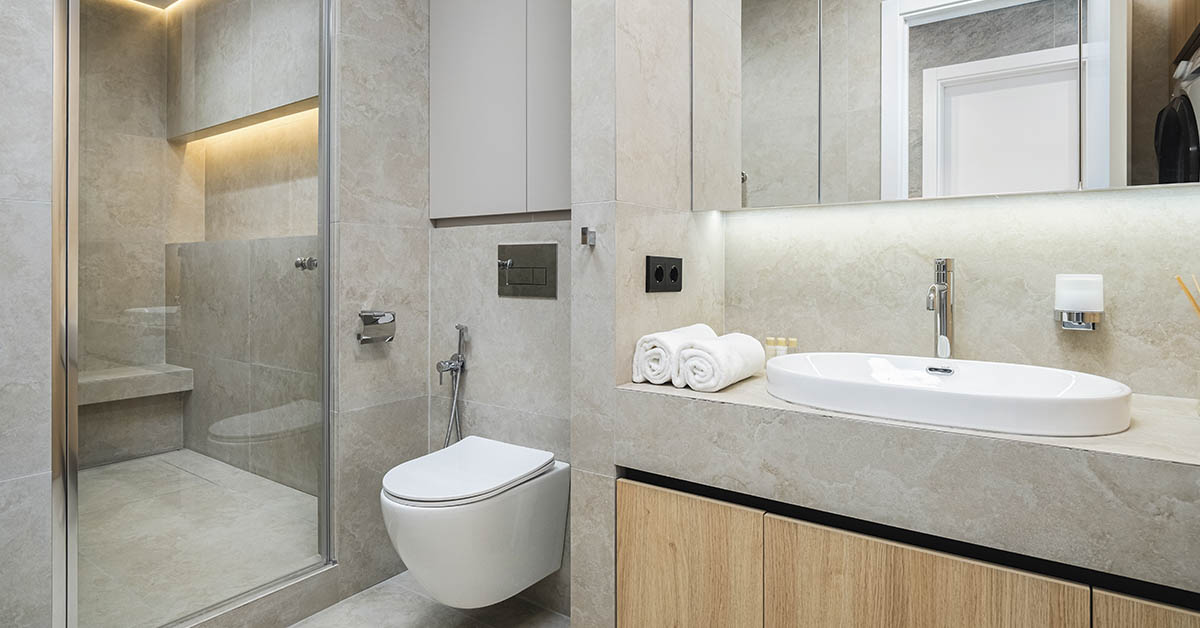Bathrooms have shifted from purely functional to versatile spaces where comfort, efficiency, and design become one. Renovation choices now focus on sustainable fixtures, better layouts, and finishes that adapt to everyday living. Updates range from eco-friendly water systems to decorative tiles and custom lighting solutions. These changes improve not only appearance but also practicality, which makes them attractive to both current homeowners and future buyers. From advanced technology to bold design features, these 20 bathroom renovation trends demonstrate the direction of modern spaces.
1. Spa-Inspired Bathrooms
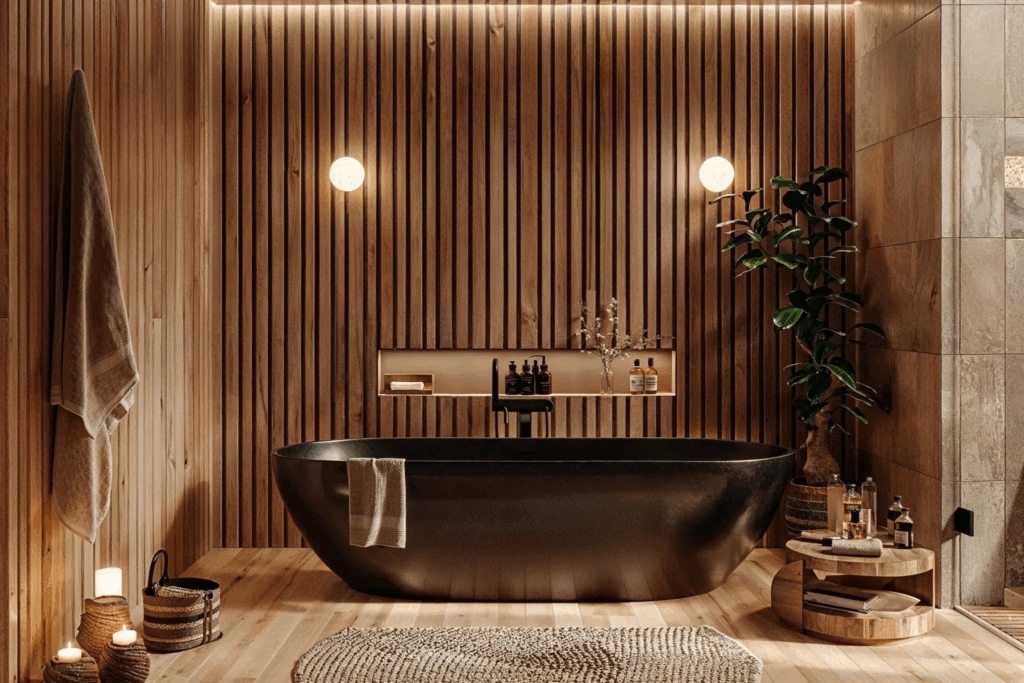
More homeowners are updating bathrooms to feel like private wellness retreats. Features such as rainfall showers, deep soaking tubs, and stone surfaces are being installed to provide a calming atmosphere. Adjustable lighting lets users shift between bright light for tasks and softer tones for relaxation. Built-in sound systems often connect to smart devices, offering music or guided meditation while bathing. Heated benches and towel racks also appear in shower zones, turning ordinary routines into more comfortable experiences.
2. Natural Materials
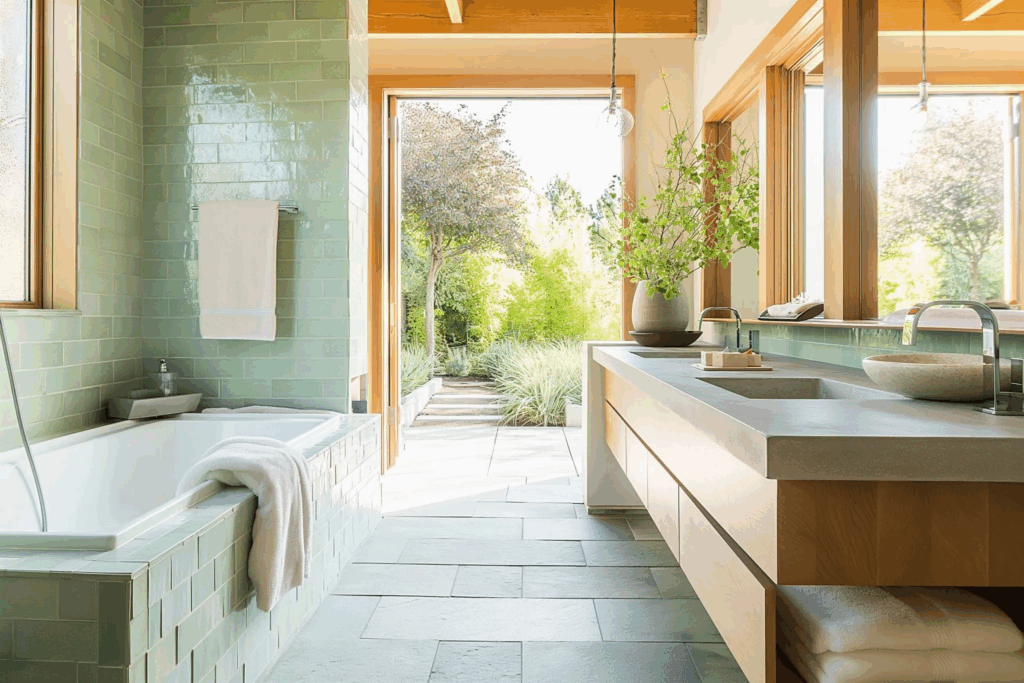
Decorilla reccomends Organic finishes such as stone, wood, and pebble textures are becoming staples in bathroom renovations. These materials last longer than synthetic options and add visual depth to modern spaces. Stone tiles with matte finishes are used in showers for slip resistance, while wooden shelving provides both function and warmth. Pebble flooring is popular for walk-in showers because of its natural grip. Homeowners incorporate live-edge wood countertops and full stone feature walls in higher-end projects.
3. Sustainable Fixtures
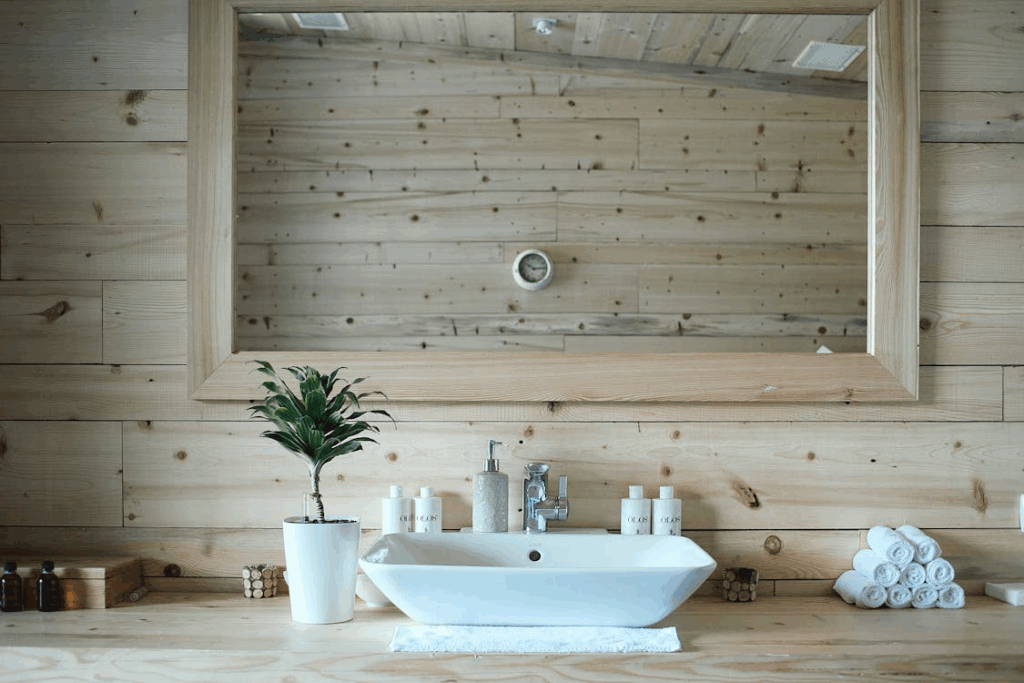
Eco-friendly fixtures are now among the most common upgrades. Low-flow toilets can save more than 12,000 gallons of water per household annually, while showerheads with aerators reduce flow but maintain pressure. Faucets with built-in temperature regulators also help cut energy waste. Recycled glass backsplashes and reclaimed wood vanities reduce demand for new raw materials. Many remodels now include LED mirror lighting and motion-sensing switches to further lower utility costs.
4. Smart Technology
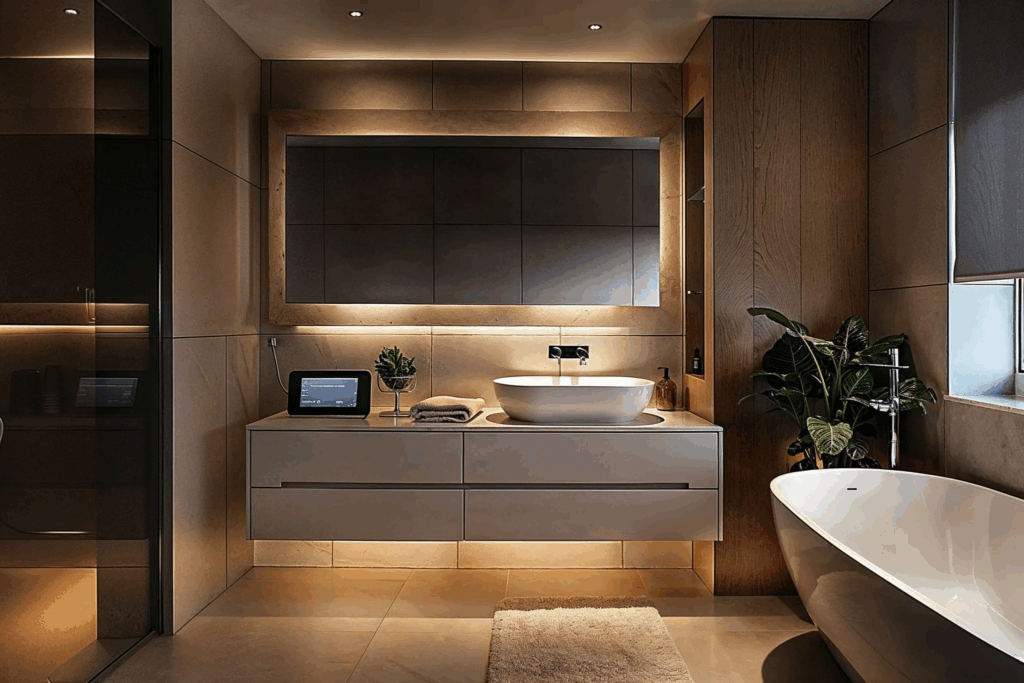
Technology has entered bathroom design in practical ways. Touchless faucets reduce germ spread and are especially useful in busy family households. Smart mirrors often include time displays, magnification panels, and lighting controls, replacing the need for separate fixtures. App-connected showers let users schedule and control water settings from their phones. Motion-activated lighting strips are being placed under vanities for safe nighttime navigation. Even humidity sensors are now being installed to control ventilation automatically.
5. Bold Color Choices
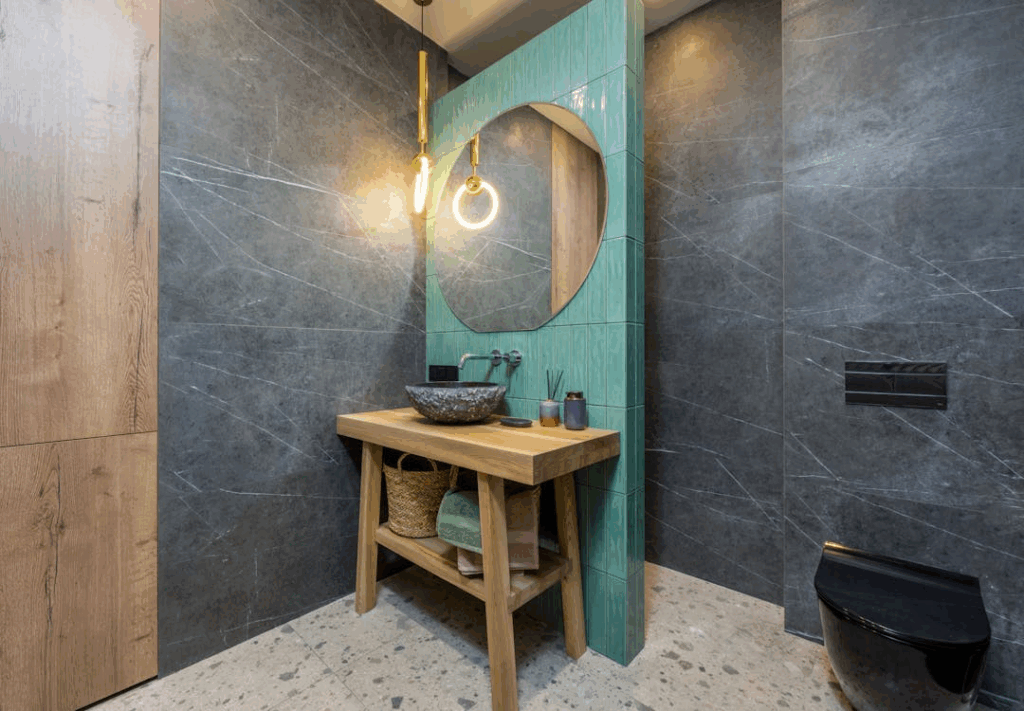
Bathrooms are no longer confined to muted tones. According to Liz from Balance + Rhythm, Rich navy cabinetry, emerald green vanities, and matte black tiles are increasingly used to break away from all-white palettes. Jewel-tone tiles in chevron or herringbone layouts are popular choices for accent walls. Black paint finishes paired with brass or gold fixtures create a striking contrast. For smaller bathrooms, homeowners often use one bold color on vanities or mirrors to avoid overwhelming the room.
6. Open Layouts
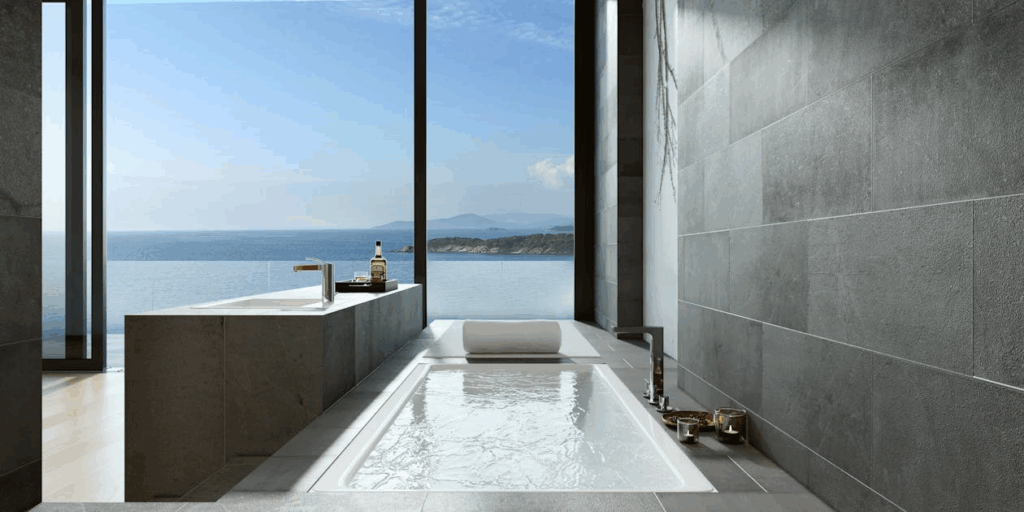
Open designs are replacing traditional segmented bathrooms. Curbless showers with integrated linear drains create smooth transitions between zones. Frameless glass enclosures eliminate barriers and help small bathrooms look larger. Large-format tiles are often used across floors and walls to achieve visual continuity. Many new builds connect dressing spaces directly to bathrooms, creating a single extended layout that feels less confined.
7. Statement Lighting
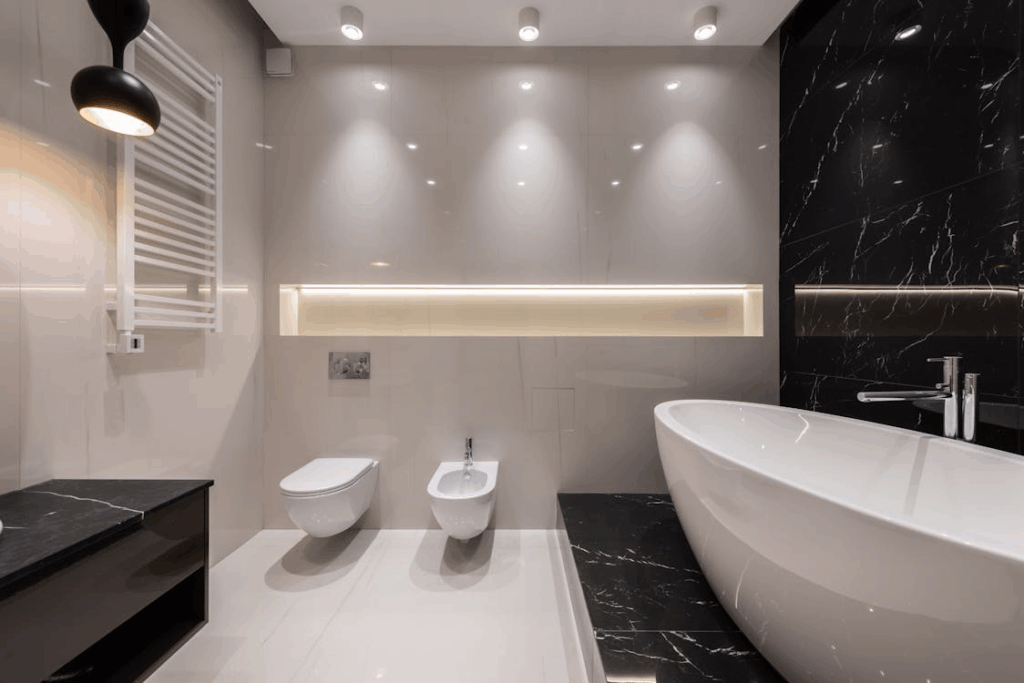
Lighting is now central to bathroom design rather than an afterthought. Oversized pendants are installed above freestanding tubs, adding illumination and style. LED strips behind mirrors provide even light for grooming tasks without creating shadows. Chandeliers in polished brass or blackened steel appear in upscale master baths. Dimmable fixtures allow the same room to be a bright work zone in the morning and a softer, calming space at night.
8. Multifunctional Storage

Storage solutions are being integrated into bathrooms to keep surfaces clear and organized. Recessed shower niches are replacing hanging caddies and bulky shelving. Vanities now feature deep drawers with dividers for hair tools, skincare, and cleaning products. Pull-out hampers built into cabinetry help keep laundry out of sight. Some modern medicine cabinets even include built-in power outlets and USB ports for charging devices while they remain tucked away.
9. Freestanding Tubs

Freestanding tubs have re-emerged as a signature feature in bathroom renovations. Oval resin models fit well into contemporary layouts, while cast-iron clawfoot tubs remain popular in traditional homes. Stone composite tubs are chosen in luxury spaces for durability and a solid feel. Placement often centers the tub under a large window or beneath a chandelier to highlight it as a focal point. Many designs now also include freestanding floor-mounted faucets to complement the look.
10. Large-Format Tiles
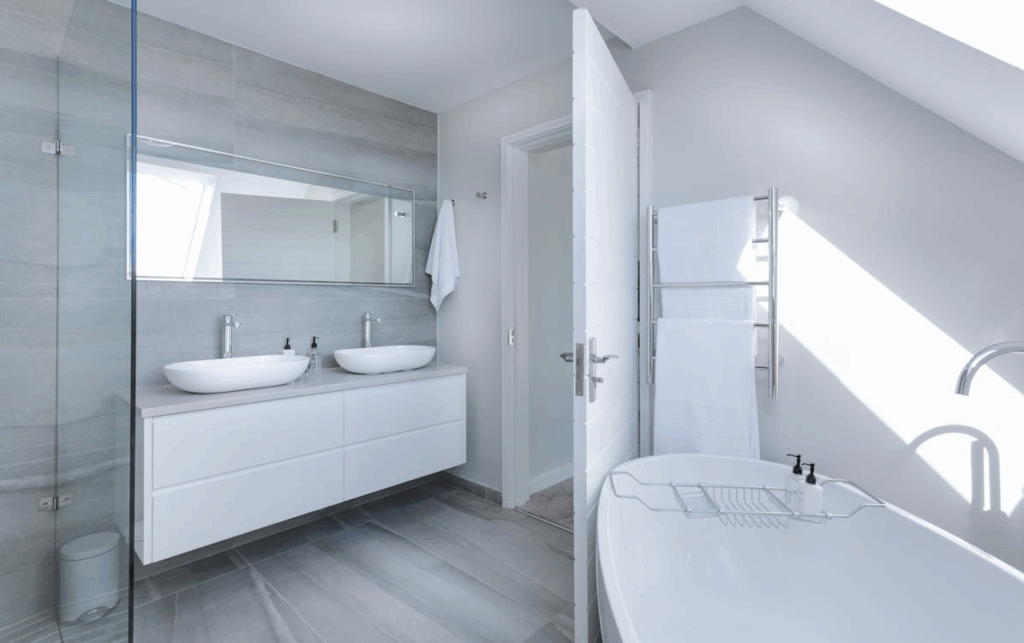
Oversized tiles are being used for both walls and floors. Porcelain slabs up to four feet across reduce grout lines, creating smooth surfaces that are easier to clean. Marble tiles in large sections are being installed for full-height shower walls. Concrete-look tiles bring an industrial style without requiring poured concrete. Many homeowners select matte finishes to reduce glare while providing slip resistance in wet zones.
11. Matte Black Fixtures

Black finishes are becoming a standard option for fixtures. Faucets, showerheads, and cabinet pulls in matte black resist water spots and fingerprints, making them practical and stylish. They are often paired with light quartz countertops for a sharp contrast. Complete shower kits, including rainfall heads and trim, are now available in matte black. Towel bars, toilet flush plates, and even floor drains are offered in the same finish to maintain consistency.
12. Floating Vanities

Floating vanities are widely chosen for their ability to save floor space. Mounted directly to walls, they give bathrooms a more open feel and make cleaning easier. Under-cabinet LED lighting is often included for visibility and safety. Finishes such as oak, walnut, and engineered veneer provide a natural appearance. Wall-mounted sinks or vessel basins are frequently paired with floating vanities to complete the streamlined look.
13. Integrated Plants
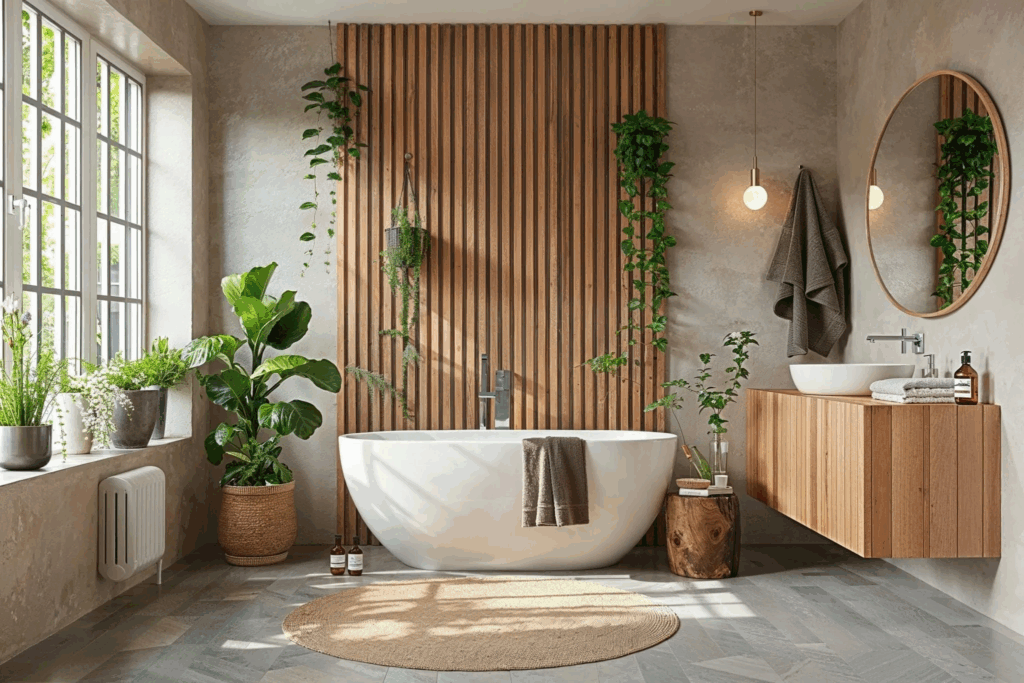
Plants are being added to soften the hard surfaces of bathrooms. Hanging planters are often suspended in corners near windows for natural light. Countertop succulents and snake plants require little maintenance and adapt well to humid conditions. Vertical green walls are appearing in luxury remodels with dedicated ventilation systems. Even small potted ferns are placed on floating shelves to take advantage of humidity.
14. Textured Walls
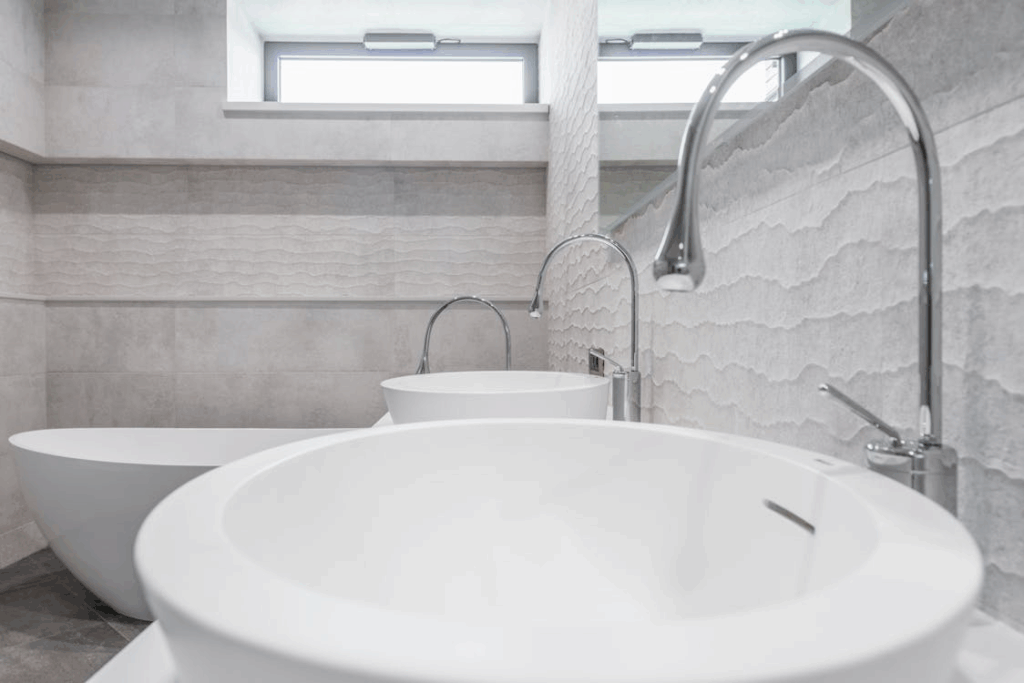
Three-dimensional tiles and panels are adding depth to bathroom walls. Wave patterns, ridges, and geometric designs catch light differently, creating visual variation. White fluted tiles are used in minimalist designs to add texture without relying on color. Decorative concrete panels offer both strength and unique surfaces. Natural stone tiles with raised finishes are also used for accent walls behind mirrors or tubs.
15. Metallic Accents
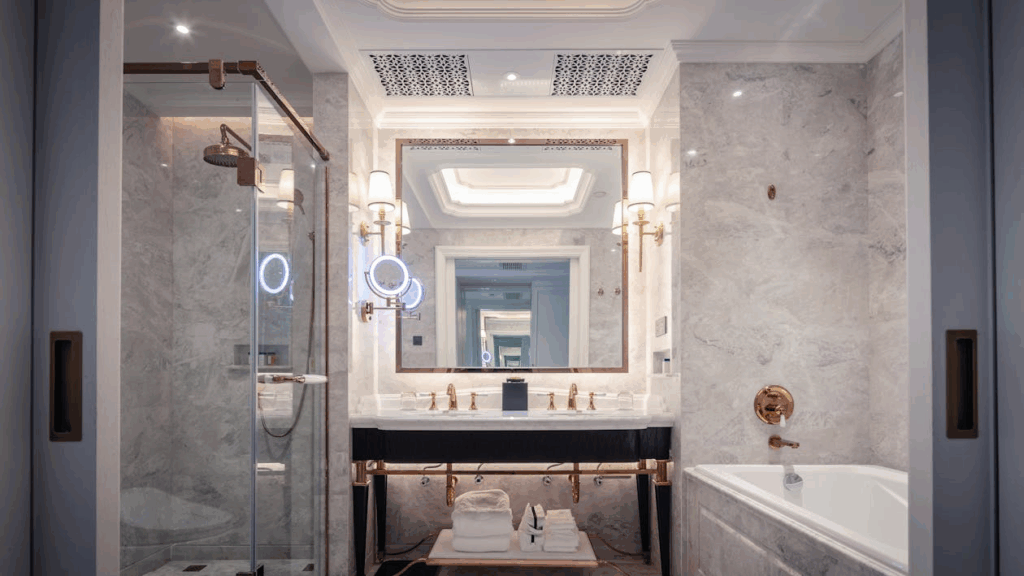
Brass, copper, and brushed gold are incorporated into fixtures and details. Brushed brass faucets pair well with white marble countertops, creating a subtle but warm effect. Copper-framed mirrors add contrast in industrial-style remodels. Gold shower trim is used as an alternative to chrome in upscale projects. Bronze sconces on either side of mirrors are common additions for balanced lighting.
16. Natural Light Enhancements
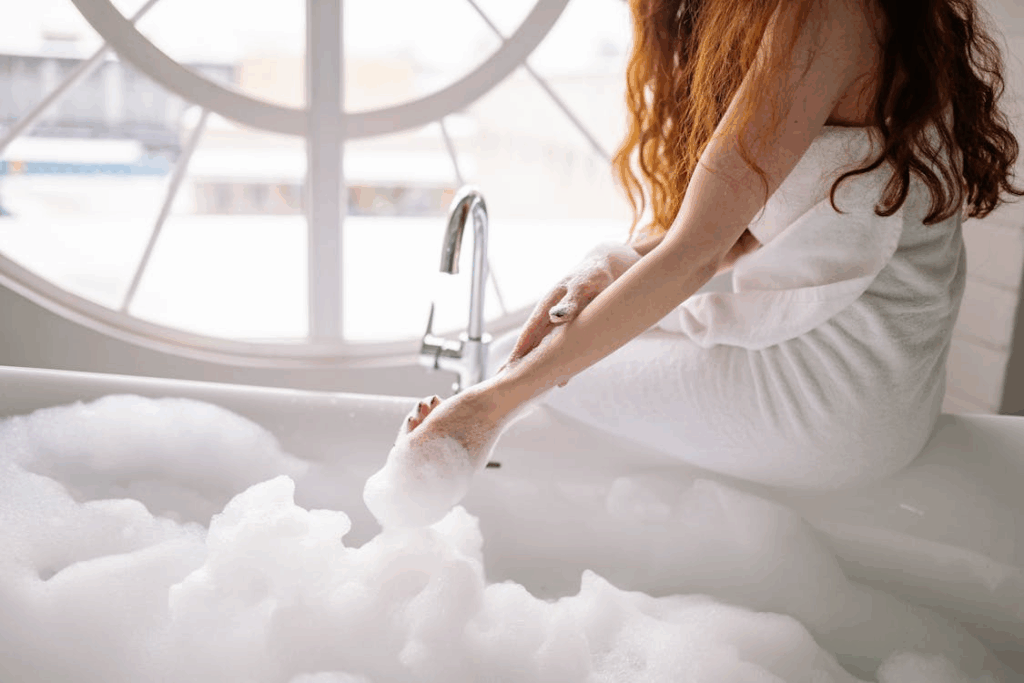
Daylight is being prioritized in bathroom layouts. Skylights above showers provide bright overhead light without sacrificing privacy. Frosted glass windows allow more illumination than small opaque panes. Solar tubes are installed in bathrooms without external walls to bring in natural light. In larger homes, sliding glass doors open bathrooms directly onto private courtyards or enclosed gardens.
17. Wet Rooms
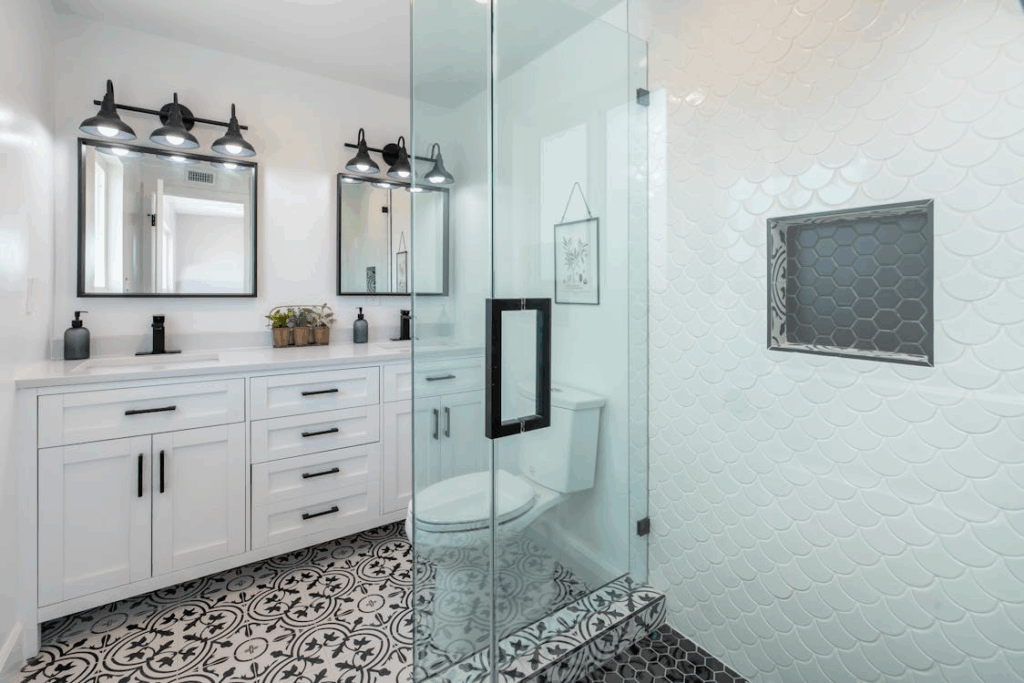
Mitchell Parker from Houzz is all for wet rooms are being added to maximize available space. Continuous tile across walls and floors eliminates transitions and creates a unified surface. Glass panels are sometimes installed to reduce splashing but keep the area open. Heated flooring is often used to prevent dampness and speed up drying times. Stone-look porcelain tiles are a common choice for these spaces because they are water-resistant and easy to maintain.
Read More: How to Fix These 3 Common Kitchen Design Errors
18. Custom Shower Systems
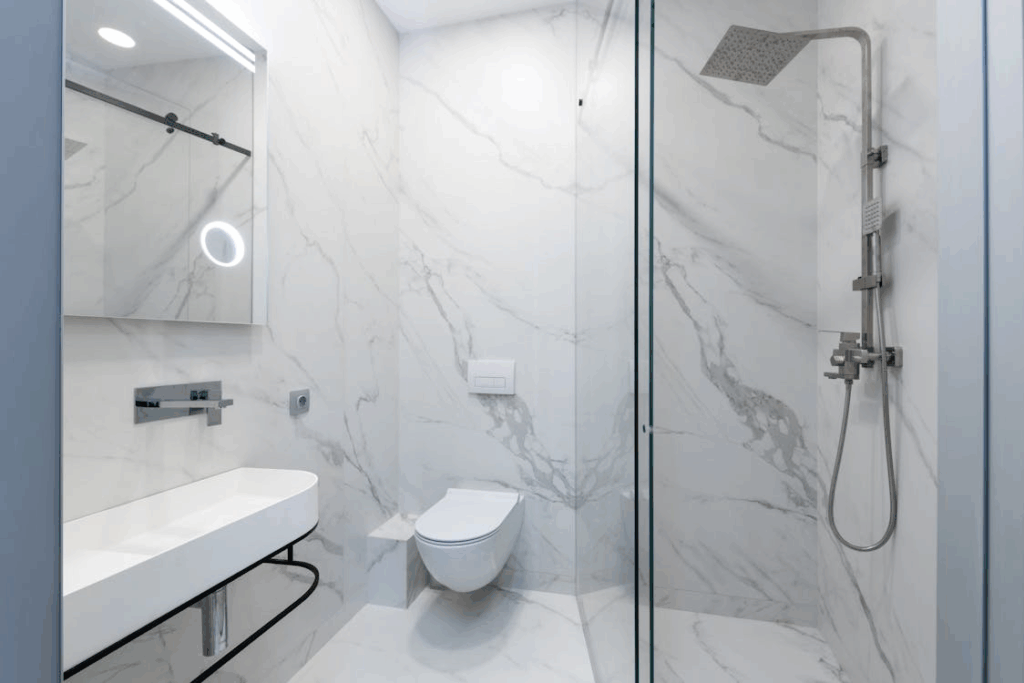
Shower designs are becoming more advanced and customizable. Multi-jet sprayers can be adjusted for both angle and pressure. Rainfall heads are combined with handheld sprayers for flexibility. Thermostatic controls maintain consistent temperatures even when other water sources are in use. Some high-end systems now include built-in steam functions, providing spa-style treatments in residential bathrooms.
19. Eco-Friendly Materials
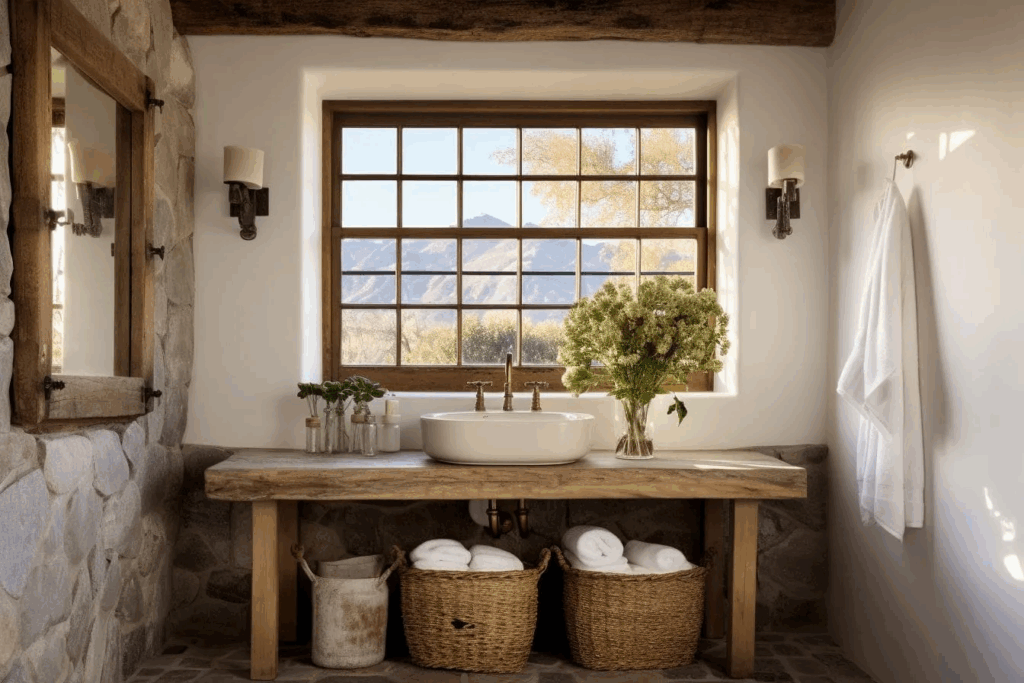
Sustainability is guiding the choice of materials in many renovations. Bamboo is used for vanities and shelving because it grows rapidly and is renewable. Recycled stone composites are replacing quarried marble in countertops. Reclaimed wood is being cut and sealed for accent walls, adding character and sustainability. Cork flooring appears in guest bathrooms with low moisture exposure as a renewable alternative to vinyl.
20. Accessible Features

Accessibility features are being integrated into bathrooms from the start of planning. Slip-resistant vinyl and textured porcelain tiles reduce fall risks. Grab bars are now available in brushed finishes that match other hardware, making them less clinical in appearance. Pocket doors replace swinging doors to provide barrier-free entry. Adjustable shower benches and handheld sprayers allow bathrooms to comfortably serve a broader range of users.
Elevating Comfort and Value

Modern bathroom renovations emphasize efficiency, comfort, and adaptability. Fixtures that save water and energy reduce costs and environmental impact. Materials like stone, bamboo, and recycled composites extend durability while supporting sustainability. Lighting, storage, and layout choices improve usability while keeping designs modern. These 20 bathroom renovation trends to elevate your home provide clear direction for creating practical, stylish, and future-ready spaces.
Disclaimer: This article was created with AI assistance and edited by a human for accuracy and clarity.
Read More: 30 Awesome Design Ideas And Tips
